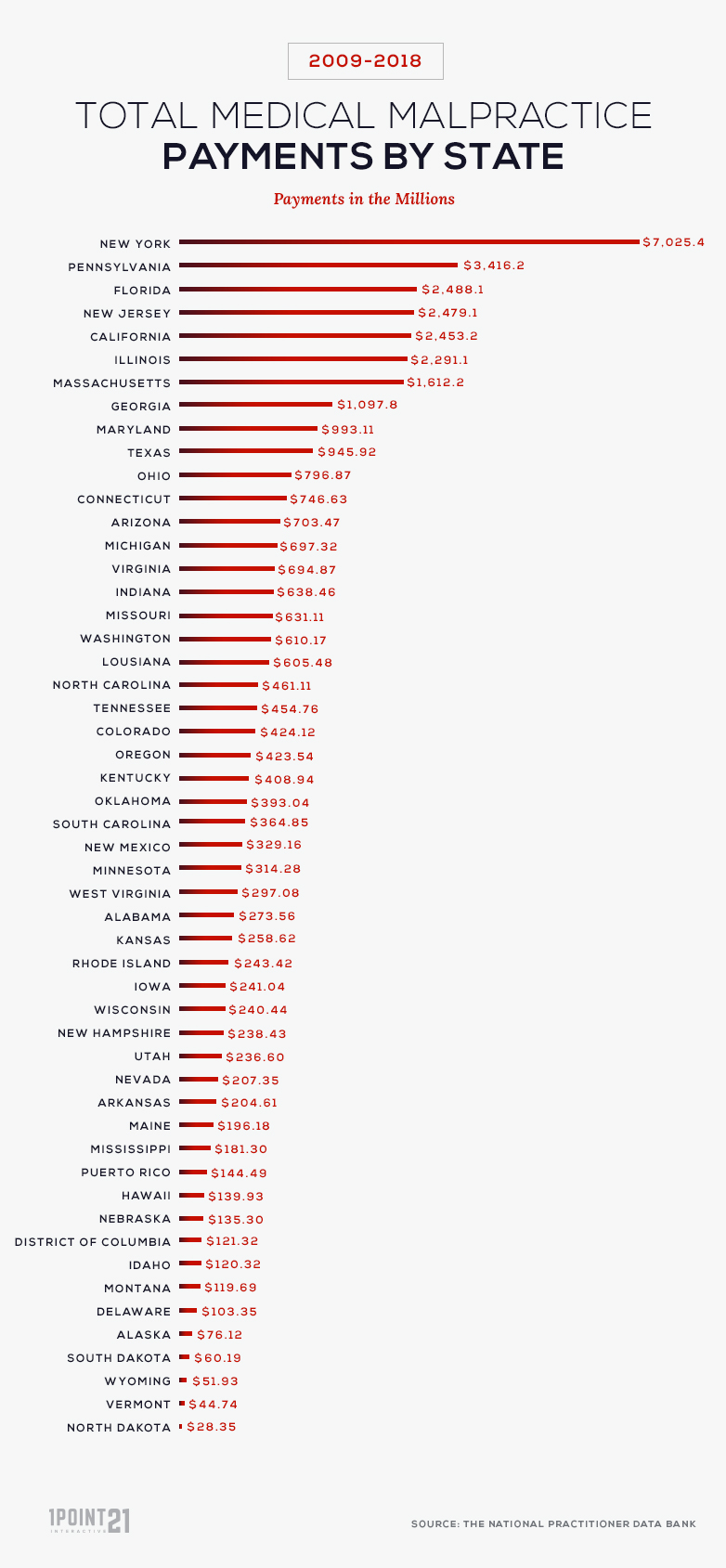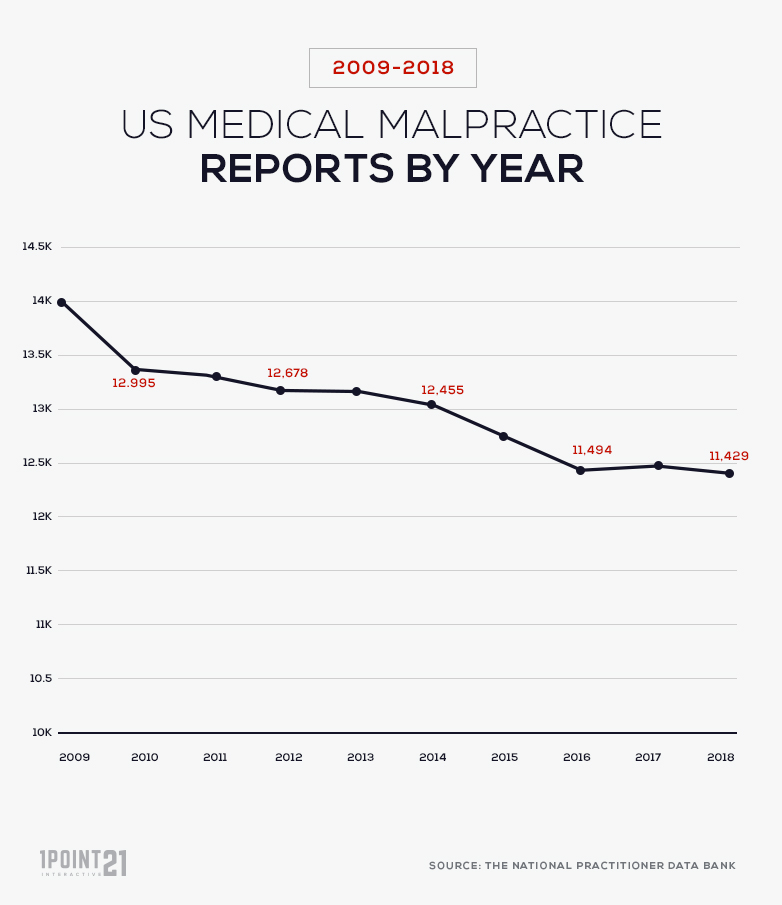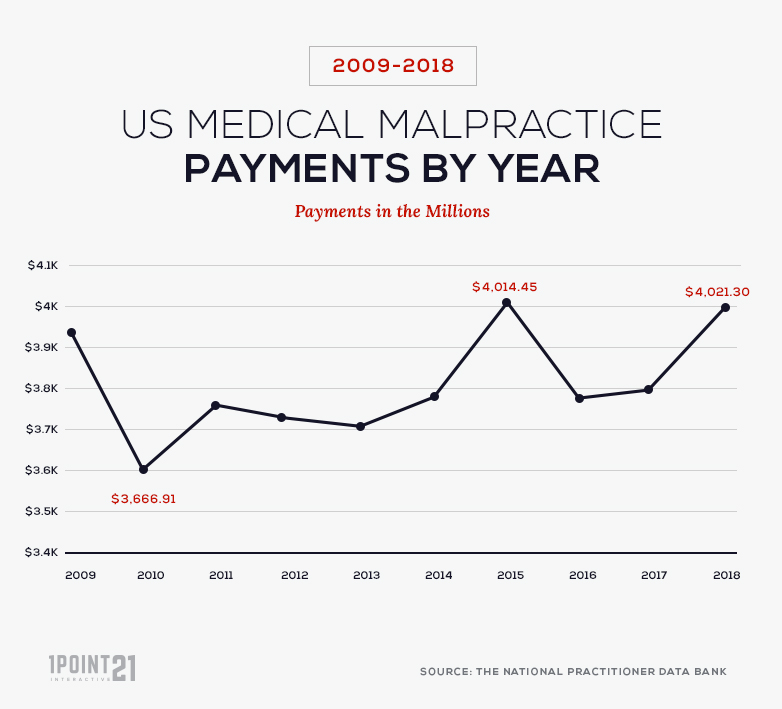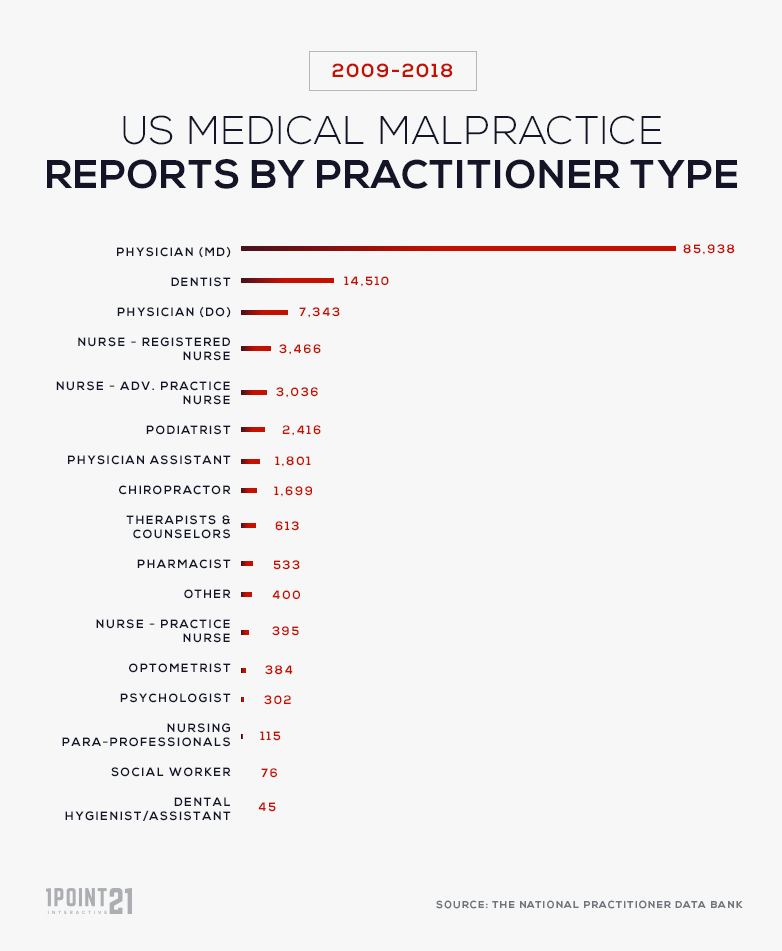CALL FOR YOUR FREE CONSULTATION
1-888-664-6974
MALPRACTICE SPECIALISTS WHO CARE ABOUT YOUR CASE
WE HOLD DOCTORS AND HOSPITALS ACCOUNTABLE.
Click for your free consultation
Finding reputable data on medical malpractice claims in the United States online can often be difficult, with false statistics and questionable numbers with no verifiable source littering the Internet and repeated ad nauseam by other websites.
This comprehensive list aims to be the definitive resource for facts, figures, statistics, and procedures regarding medical malpractice claims in the United States. It includes information sourced from peer-reviewed studies, physician surveys, and information retrieved from the National Practitioner Data Bank (NPDB), an exhaustive government database of all medical malpractice reports and payments in the United States.


According to NPDB data, the average payout for a medical malpractice claim from 2009-2018 was approximately $309,908.
There have been, on average, 12,414 cases of medical malpractice reported to the NPDB annually for the past decade (2009-2018).
According to a study by Johns Hopkins University, more than 250,000 people in the U.S. die every year from medical errors and negligence. This makes medical malpractice the third-leading cause of death in the United States.
According to the New England Journal of Medicine, 99 percent of physicians face at least one lawsuit by age 65.
According to data from the Rand Corporation, the average physician spends over ten percent of his or her career dealing with litigation.
The time spent on a medical malpractice suit may vary. A 2006 study by the New England Journal of Medicine found that the average time for a medical malpractice suit took five years, from the moment of the injury/damage to the closing of the case.
However, a 2017 Medscape survey of physicians indicates that the majority of medical malpractice lawsuits took 1 to 2 years.

According to NPDB data, New York had the largest amount of medical malpractice reports from 2009-2018, with 16,688 – followed by California and Florida, with 13,157 and 10,788 reports, respectively.
North Dakota only had 126 total reports of medical malpractice – the lowest by far within the continental United States.
According to NPDB data, the state of New York had the highest total medical malpractice payments, totaling $7.025 billion – followed by Pennsylvania, with $3.416 billion. North Dakota had the lowest amount of medical malpractice payments, totaling just $28.35 million.

From 2009-2018, the number of medical malpractice reports has decreased from
14,017 to 11,429 – an 18.5% decrease.

Since 2009, a total of $38.5 billion has been paid out to victims of medical malpractice.
Yearly payment totals have been largely inconsistent. The lowest total amount of
medical malpractice payments occurred in 2010, with approximately $3.67 billion
paid out to medical malpractice victims. The total amount peaked in 2015,
when victims collectively received $4.01 billion in damages.

The overwhelming majority of medical malpractice reports are against medical doctors, with
over 85,000 reports from 2009-2018. By contrast, the next ranking profession is dentists, with
14,510 reports.

$216.7 million – awarded to Allan Navarro by a Florida jury in 2006 for a misdiagnosis of stroke symptoms
$190 million – awarded to 8,000 plaintiffs by Johns Hopkins Hospital in 2014 on behalf of Dr. Nikita Levy, a gynecologist who had been secretly taking photos and recording videos of his patients.
$172 million – awarded to Tiffany Applegate by a Bronx Jury in 2014 for improper care and advice by paramedics, leading to severe brain damage and paralysis.


According to the IRS, no:
“If you receive a settlement for personal physical injuries or physical sickness and did not take anitemized deduction for medical expenses related to the injury or sickness in prior years, the full amount is non-taxable. Do not include the settlement proceeds in your income.
The proceeds you receive for emotional distress or mental anguish originating from a personal physical injury or physical sickness are treated the same as proceeds received for Personal physical injuries or physical sickness above.”
The statute of limitations on medical malpractice cases generally varies by state, and may include two separate deadlines:
The standard deadline to file a claim starts from the moment the malpractice actually occurred.
However, most states have a discovery exception deadline, in which the time limit starts when the patient discovers the malpractice – or reasonably should have discovered the malpractice.
The amount of your compensation may depend on the severity of your injuries, the length of time you are incapacitated from the injury, and the lasting effects of the incident on your life moving forward. However, there are also state laws in place across the United States that may limit the compensation you receive in a medical malpractice case – otherwise known as a cap on damages.
Six states have caps on total damages in medical malpractice cases – this includes both economic & non-economic damages:
24 states have caps on non-economic damages:
20 states have no caps on damages:
Interestingly, Colorado is the only state in the country with caps on both total damages and non-economic damages. It claims a $1 million “umbrella” cap, while also enforcing a $300,000 limit on non-economic damages.
Despite the high figures regarding medical malpractice cases and payments, it is important to note that these statistics may not necessarily reflect the actual number of medical malpractice incidents in the country every year.
Some argue that medical malpractice is widely underreported in the country. Issues such as misdiagnosis and failure to diagnose often are not fully disclosed to patients – so when complications arise, it may be difficult to find any seeming negligent acts by medical professionals.
Additionally, the NPDB only reports on the quantity of medical malpractice payouts – not on actual instances of medical malpractice. Many cases are often denied or dismissed due to extenuating circumstances – despite legitimate grounds for negligence.
As a result, deaths and injuries stemming from medical malpractice incidents may be far higher than the data suggests – and is something that certainly warrants further investigation.